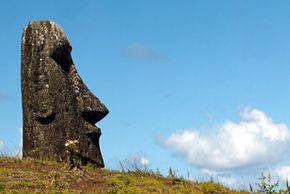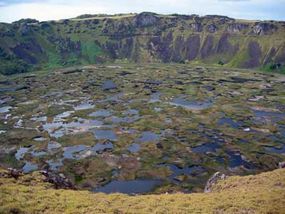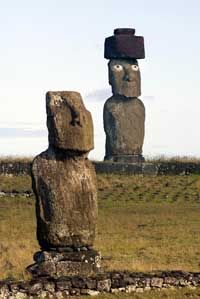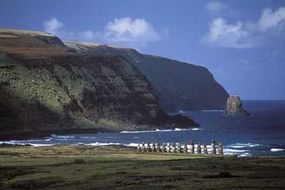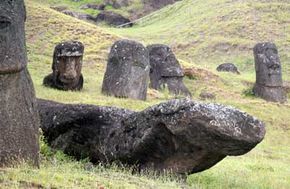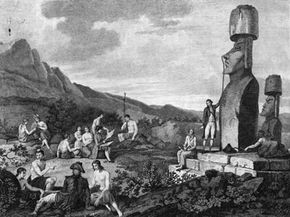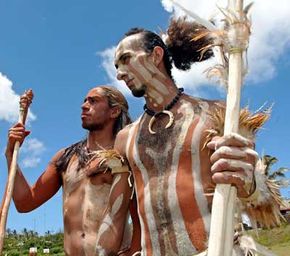Much of Easter Island's haunting past remains a mystery, though archaeologists have offered many theories about the people, their culture and their fateful decline. The eerie story of Easter Island is not only a lesson in the history of [b]Oceania, but also a cautionary tale of environmental plunder.
Easter Island got its name from the Dutch admiral Jacob Roggeveen, who landed there on Easter Sunday in 1722 [source: Metropolitan Museum of Art]. For centuries, the island -- also called Rapa Nui and Isla de Pascua -- was a barren wasteland: a blank canvas for the hundreds of moai that lined its cliffs and beaches. The moai, enormous man-made stone statues, are Easter Island's most recognizable feature. Crafted from volcanic ash, the moai weigh up to 82 tons (74.39 metric tons) and loom up to 32.63 feet (9.8 meters) high [source: NOVA]. But the restored ones that stand today are a testament to modern archaeological efforts -- the original moai were torn down centuries ago.
Advertisement
To understand how these magnificent statues worked, it's necessary to understand their creators. Easter Islanders hailed from Polynesia, a smattering of nearly a thousand islands in the Pacific Ocean. Polynesians are bold sailors and navigators. The sky is their compass, and the ancient islanders constructed seaworthy vessels from wood [source: NOVA]. Scholars believe that the Easter Islanders set sail from East Polynesia in 400 A.D. and that they landed on the shores of the island after two weeks adrift in a vast ocean. We can't be sure if they headed toward Easter Island with a specific purpose -- if they knew it even existed -- or if strong winds and rough seas from an El Niño-type weather pattern forced them off course [source: NOVA]. No matter the purpose of their voyage or the goal of their ultimate destination, they took refuge in a very strange land.
The Polynesian sailors who settled Easter Island are commonly identified as the Rapanui, after the Polynesian name for the island itself: Rapa Nui. For hundreds of years, the Rapanui's civilization thrived. But things were about to change drastically. The same people that erected the awe-inspiring moai would alter the ecosystem of the island forever. They would be gifted artists and engineers in the height of their civilization but ruthless warriors in their darkest, most desperate hours. Few civilizations in history have risen and fallen so fast -- and so inexplicably. In this article, we'll learn about the Easter Islanders' sophisticated civilization and their rapid descent into ruin.
Next, we'll learn about the island itself and how its settlers adapted to it.
Advertisement
